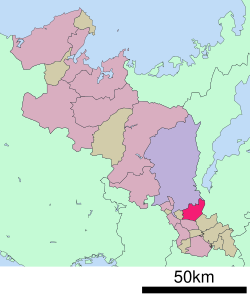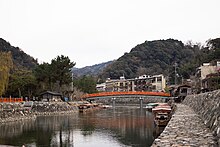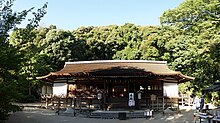You can helpexpand this article with text translated fromthe corresponding articlein Japanese.Click [show] for important translation instructions.
|
Uji(Vũ trị thị,Uji-shi)is acityonthe southern outskirts of the cityofKyoto,inKyoto Prefecture,Japan.
Uji
Vũ trị thị | |
|---|---|
 Byōdō-in, a World Heritage Site | |
 Location of Uji inKyoto Prefecture | |
| Coordinates:34°53′4″N135°47′59″E/ 34.88444°N 135.79972°E | |
| Country | Japan |
| Region | Kansai |
| Prefecture | Kyoto Prefecture |
| First official recorded | early 5th century |
| City Settled | March 1, 1951 |
| Government | |
| • Mayor | Atsuko Matsumura |
| Area | |
• Total | 67.54 km2(26.08 sq mi) |
| Population (October 1, 2020) | |
• Total | 179,630 |
| • Density | 2,700/km2(6,900/sq mi) |
| Time zone | UTC+9(Japan Standard Time) |
| Tree | Acer |
| Flower | Kerria japonica |
| Bird | Alcedo atthis |
| Phone number | 0774-22-3141 |
| Address | 33 Uji Biwa, Uji-shi, Kyōto-fu 611-8501 |
| Website | www |




Founded on March 1, 1951, Uji is between the two ancient capitals ofNaraandKyoto.The city sits on theUji River,which has its source inLake Biwa.
As of 1 October 2020[update]Uji has a population of 179,630 and is the second largest city inKyoto Prefecture.It has an area of 67.54 km2,giving it apopulation densityof 2,660 persons per km2.[1]
History
editIn the 4th century the son ofEmperor Ōjinestablished a palace in Uji. The 11th-century author,Murasaki Shikibu,set much of the final chapters ofThe Tale of Genjiat Uji.[2]
Thefirst battle of Ujiin 1180 was the first clash of theGenpei War.Tairaforces caught up withMinamotoforces that were attempting to make their way toNaraand defeated them. Later in the war, two factions of Genji clashed at thesecond battle of Ujiin 1184. In 1221, theJōkyū Warwas decided at thethird battle of Uji,in which forces of theKamakura shogunatedefeated the retiredemperor Go-Toba,consolidating the shogunate's control over Japan and theHōjō clan's control over the shogunate.
ShōgunAshikaga Yoshimitsu(1358–1408) promoted cultivation ofUji teain the area. Since then Uji has been an important production and distribution center of superior quality green tea. Tsuen tea has been served since 1160 and is still sold in the oldest tea shop in Japan and possibly the world—theTsuen tea shop.[3]In the 15th century,shimamonotea jars destined to be used in theJapanese tea ceremony[4]were brought by theshōgunfromLuzonto Uji.
Uji contains the ethnic Korean enclaveUtoro district,which was formed from forced laborers who were made to build an airstrip in Kyoto beginning in 1941.[5][6]
Geography
editDemographics
editPer Japanese census data,[1]the population of Uji has recently plateaued after decades of strong growth.
| Year | Pop. | ±% |
|---|---|---|
| 1920 | 16,807 | — |
| 1930 | 21,355 | +27.1% |
| 1940 | 27,748 | +29.9% |
| 1950 | 38,231 | +37.8% |
| 1960 | 47,336 | +23.8% |
| 1970 | 103,497 | +118.6% |
| 1980 | 152,692 | +47.5% |
| 1990 | 177,010 | +15.9% |
| 2000 | 189,112 | +6.8% |
| 2010 | 189,608 | +0.3% |
| 2020 | 179,630 | −5.3% |
| Source:[1],[1] | ||
Sightseeing and events
editMost visitors are attracted to Uji for its centuries-old historic sites, which include manyShinto shrines,BuddhisttemplesandHindu Shrines.Among the most famous are theUjigami Shrine(built in 1060) and theByōdō-inthat are part of the UNESCO World Heritage Site "Historic Monuments of Ancient Kyoto".TheByōdō-in,with its Amida (Phoenix) Hall built in 1053, is featured on the obverse side of the10 yen coin.It was also featured on several Japanese postage stamps, a. o. of 1950, 1957 and 1959.
Other religious sites include theManpuku-ji,the head temple of theŌbakuZensect, built inChineseMingstyle in 1661 and theZentemple Kōshō-ji, with its Kotozaka entrance (framed with dense thickets ofcherry,kerria,azalea,andmapletrees, each of which dramatically changes color with the seasons) constructed in 1648. Noteworthy is the Mimuroto-ji, which is famous for its purple hydrangeas. The city features numerous other smallShintoshrines. With a few exceptions, most of the important historical sites are in walking distance of one another and all are easily accessed by rail.
The last ten chapters of the Japanese classicnovelThe Tale of Genjitake place in Uji, and so there isThe Tale of Genji Museum.
Uji has many natural attractions, including its scenic riverside, large parks, and a botanical garden. Slightly upriver from Uji bridge, theAmagase Damspans the river and day trippers can walk to its base in about an hour. The route, which begins directly across from Keihan Uji Station, is along the river on a paved road and offers access to several grassy open spaces where people can rest and picnic.
The city hosts two major festivals each year. The Agata Festival, held on June 5, begins in the early morning and runs until late at night. Like many cities in Japan, Uji hosts an hours-long fireworks festival on August 10. Both events draw huge crowds and require that the town's main thoroughfare to be shut down.
There iscormorant fishingin summer during the evening, from mid-June to late September.
Media
edit- FM Uji
- Jonan Shimpo
- Kyoto Animation,the story ofSound! Euphoniumalso takes place in Uji.
- Rakunan Times
Transportation
editRail
editUji is served by three rail companies:JR West,Keihan,andKintetsu.The Keihan line which runs primarily betweenKyotoand downtownOsakaserves the city via the branchUji Linerunning from Chushojima station and ending along the river atKeihan Uji Stationbeside the Uji Bridge. The station is close to Uji'sTale of GenjiTown, Uji Bridge, and the Byodoin. All trains on this line stop at every station.
TheJR Nara Lineruns betweenKyotoandNara.JR Uji stationwas, until a few years ago, fairly rural but was recently rebuilt to better serve the city. Architecturally it mimics the Byodo-in and is on the opposite side of the Uji river, about 10 minutes' walk from Keihan Uji Station. The clock in front of the station is of special interest and, every hour on the hour, opens to reveal an automated show that celebrates the town's heritage as a center of tea production. LikeKeihan Uji Station,JR Uji has easy access to the same sites. The station is served by local and express trains.
Kintetsuserves West Uji with a line between Kyoto and Nara and does not have a station named for the town. The line is primarily used by commuters and includesOgura,Iseda,andŌkubo.No stations are close to the main tourist sites.
Bus
editLocal buses have routes in the city andpublic transportationis good. Charter buses to and from theKansaiInternational (KIX) andItamiairports can be caught at most of the train stations.
Roads
editUji is south of the mainMeishin Expresswayand is served directly by the Keiji Bypass, atoll roadthat was completed a few years ago. The Keiji Bypass circumventsKyotoandŌtsuwhich can be subject to traffic jams. The road is notable for its hightrestlesand series of longtunnels— including one that is approximately six miles long. The Keiji Bypass links to Dai Ni Keihan Road (Number Two Kyoto Osaka Road) which is under construction and usable for at least part of its length.
Non-toll roadsincludeRoute 1which runs betweenKyotoandOsakaand Route 24 which runs betweenKyotoandNara.These roads are usually filled with traffic and have many stoplights. Close by is Route 307, which runs east/west along the southern edge of the city betweenOsakaandShigaprefecture. This is a fairly rural road that leads through the mountains and, once away from the urban centers, makes a nice day trip.
Of special interest tomotorsportsenthusiasts is the Ujigawa Line (Uji River Line). This twisty road parallels the Uji River between Uji and Otsu and is a favorite for racers. The road is dangerous and often claims lives. Due to numerous accidents, the route is closed tomotorcyclesfor most of August, when Japanese schools are typically out of session.
Friendship cities
editUji has friendship agreements with three other cities:[7]
Notable people from Uji
edit- Takanori An'yōji,Japaneseprofessional shogi player,ranked 7-dan
- Masako Chiba,Japaneselong-distance runner
- Nana Fujii,Japanesewomen's professional shogi playerranked 1-dan
- Yoshiyuki Hasegawa,formerJapanesefootball player
- Tetsuya Kanmuri,Japaneseheavy metalsinger
- Makoto Kakuda,Japanesefootball playerwho plays forV-Varen Nagasaki
- Akira Kawashima,Japanese comedian,tarentoand actor
- Keika Kitamura,Japanesewomen's professional shogi playerranked 1-dan
- Ryo Matsumura,Japanesefootballplayer forChiangmaiinThai League 2
- Hiroe Minagawa,Japanesesport wrestler(Freestyle wrestling)
- Shizuka Nakamura,Japanesegravure idolandactress
- Yusuke Nakatani,formerJapanesefootball player
- Kei Shimizu,Japanese comedian(Real Name: Keita Shimizu,Nihongo:Thanh thủy khuê thái,Shimizu Keita)
- Novala Takemoto,Japanese author andfashion designer(Real Name: Toshiaki Takemoto,Nihongo:Nhạc bổn nhẫm minh,Takemoto Toshiaki)
- Yuka Tsujiyoko,Japanesevideo game musiccomposer (Real Name: Yuka Bamba,Nihongo:バンバユカ,Banba Yuka)
References
edit- ^abcUji population statistics
- ^Green, Michelle (31 December 2008)."Kyoto Celebrates a 1,000-Year Love Affair".New York Times.Retrieved11 December2017.
- ^"Tsuen Tea House - the oldest teahouse in the world".Archived fromthe originalon 2017-02-02.
- ^"Quests of the Dragon and Bird Clan: Luzon Jars (Glossary)".5 September 2006.
- ^McNeill, David; Hippin, Andreas (July 6, 2005)."Kyoto Korea Town fights for survival".The Asia-Pacific Journal: Japan Focus.Retrieved2023-09-19.
- ^McCurry, Justin (2022-07-18)."'Utoro is my identity': can a museum heal the scars of Korean migrants in Japan? ".The Guardian.ISSN0261-3077.Retrieved2023-09-19.
- ^Vũ trị thị hữu hảo đô thị の thiệu giới(in Japanese).RetrievedAugust 2,2007.


